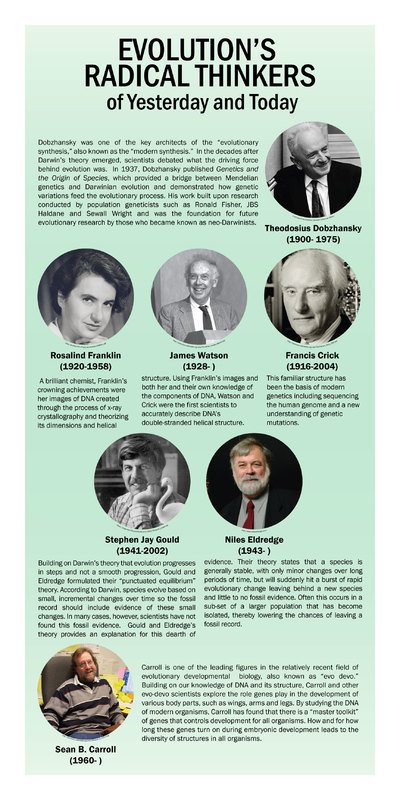Evolution's Radical Thinkers 2
Theodosius Dobzhansky (1900- 1975)
Dobzhansky was one of the key architects of the “evolutionary synthesis,” also known as the “modern synthesis.” In the decades after Darwin’s theory emerged, scientists debated what the driving force behind evolution was. In 1937, Dobzhansky published Genetics and the Origin of Species, which provided a bridge between Mendelian genetics and Darwinian evolution and demonstrated how genetic variations feed the evolutionary process. His work built upon research conducted by population geneticists such as Ronald Fisher, JBS Haldane and Sewall Wright and was the foundation for future evolutionary research by those who became known as neo-Darwinists.
Rosalind Franklin (1920-1958)
A brilliant chemist, Franklin’s crowning achievements were her images of DNA created through the process of x-ray crystallography and theorizing its dimensions and helical structure
James Watson (1928- )
Using Franklin’s images and both her and their own knowledge of the components of DNA, Watson and Crick were the first scientists to accurately describe DNA’s double-stranded helical structure.
Francis Crick (1916-2004)
This familiar structure has been the basis of modern genetics including sequencing the human genome and a new understanding of genetic mutations.
Stephen Jay Gould (1941-2002) and Niles Eldredge (1943- )
Building on Darwin’s theory that evolution progresses in steps and not a smooth progression, Gould and Eldredge formulated their “punctuated equilibrium” theory. According to Darwin, species evolve based on small, incremental changes over time so the fossil record should include evidence of these small changes. In many cases, however, scientists have not found this fossil evidence. Gould and Eldredge’s theory provides an explanation for this dearth of evidence. Their theory states that a species is generally stable, with only minor changes over long periods of time, but will suddenly hit a burst of rapid evolutionary change leaving behind a new species and little to no fossil evidence. Often this occurs in a sub-set of a larger population that has become isolated, thereby lowering the chances of leaving a fossil record.
Sean B. Carroll (1960- )
Carroll is one of the leading figures in the relatively recent field of evolutionary developmental biology, also known as “evo devo.” Building on our knowledge of DNA and its structure, Carroll and other evo-devo scientists explore the role genes play in the development of various body parts, such as wings, arms and legs. By studying the DNA of modern organisms, Carroll has found that there is a “master toolkit” of genes that controls development for all organisms. How and for how long these genes turn on during embryonic development leads to the diversity of structures in all organisms.
